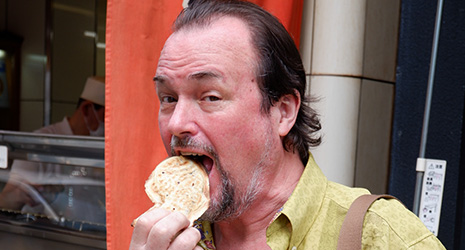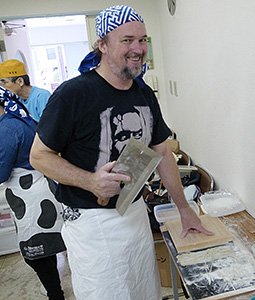INDEX
- English
- 日本語

David Conklin, eating taiyaki from a long-established shop in Ningyocho - English
- 日本語

Eating soba noodles at a neighborhood restaurant

Posing in front of a portable shrine carried in the Kanda Matsuri, a famous Shitamachi festival 
Making soba noodles
July 2020
Sharing a Love of Tokyo’s Food

Holding a Master’s degree in Japanese history, David Conklin from the United States shares his love and extensive knowledge of Tokyo’s traditional food culture as a writer and tour guide with people in Japan and abroad.

Nihonbashi Ningyocho is a district in the Shitamachi (lower town) area of Tokyo, initially constructed by filling in marshland and later developed as a commercial area in the Edo period (1603–1867). The name Ningyocho is said to stem from the fact that many people related to the traditional Japanese puppet show, Ningyo-joruri (“ningyo” means doll or puppet), once lived here, including puppet makers and puppeteers. Even today, it is a lively area where many historical eateries, Japanese sweet shops, craft shops, and more line the streets. There are also many seasonal festivals and markets in the neighborhood.
“I love Shitamachi, where you can enjoy traditional foods and culture. The people are easy to connect with and it’s easy to make friends.”
So says David Conklin, a native of Portland, Oregon, on the west coast of the United States, who now lives in Ningyocho. Conklin introduces the appeal of Japanese food, especially the food of Tokyo around the Shitamachi area, through his work as a writer and tour guide.
As a student of modern Japanese history in Portland, Conklin developed an interest in Japanese food, and in graduate school, he began to research Japanese food culture. During his research, he met a Japanese woman while visiting Tokyo to study Japanese, and they married in 2007. Since then, he has made his home in Ningyocho.

The district is home to a remarkably large number of restaurants for such traditional Japanese fare as soba (buckwheat) noodles, sushi and yakitori (grilled chicken), as well as many retail shops specializing in tofu, rice, vegetables, and other foods. Conklin once counted the number of restaurants, izakaya pubs and coffee shops within a 7-minute or so walking distance of his house and found there were close to 750. Visiting these shops by bicycle or on foot to eat or shop is something he says he still loves very much. Before the world-famous Tsukiji fish market moved to Toyosu in 2018, he says he would regularly cycle the 10 minutes from home to shop in Tsukiji for ingredients for dinner.
“Japanese food is very different from that of other countries. There are a great variety of foods, including all kinds of fermented foods, raw fish sashimi, fried foods that have uniquely evolved from Western food, and more. Japan is a paradise to me,” smiles Conklin.
Of all these foods, Conklin's favorite is soba noodles. At lunch time, he often gets on his bicycle to visit one of the local soba restaurants, saying he has been to more than 100 every year for several years.
In Japan, it isn’t considered rude to slurp one’s noodles, since doing so enhances the aroma of the noodles and soup. Conklin confesses to being a vigorous slurper of noodles, and says he is even sometimes complimented on it by the proprietors of the noodle restaurants. In fact, he is now so used to eating noodles in this way that he sometimes forgets his manners in restaurants in the United States and upsets some other customers by slurping pasta.
Conklin also likes to make soba noodles and eats them together with his family.
“Soba noodles are delicious, cheap, and very healthy. Buckwheat – the main ingredient – is cultivated across the globe, and noodle dishes are familiar in many cultures. After sushi, I think that soba noodles are the Japanese food that will next catch on around the world. I am now working on a book in English on soba noodles,” says Conklin.

Conklin has been giving food tours targeting tourists from overseas and people in the food industry for a number of years. The tours take in places like Tsukiji fish market, long-established restaurants, and the Kappabashi district, which is famous for cookware, while Conklin introduces the food culture of Tokyo, from both the Edo and modern eras. He also offers tours customized to participants’ requests, such as for tours of sweet shops or sushi restaurants. The tours have been taken up by Japanese media outlets, and Conklin is widening his appeal, appearing in newspapers, magazines and on TV.
“I will start the food tours back up once the COVID-19 pandemic calms down. I’m also now planning tours to experience the local cuisine, craft beers, whiskey and so on of various other parts of Japan, not just Tokyo,” says Conklin.
The appeal of Japanese food will no doubt continue to spread worldwide thanks to the enthusiasm and insatiable curiosity of non-native foodies like Conklin.

